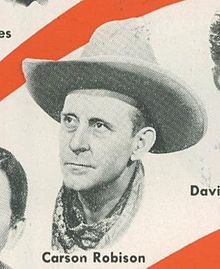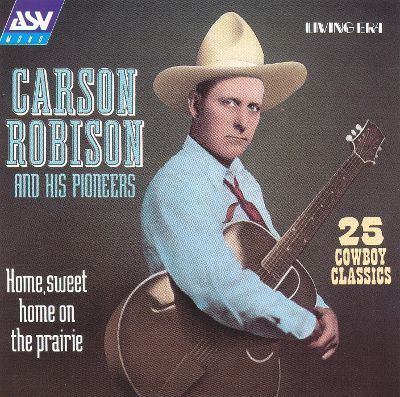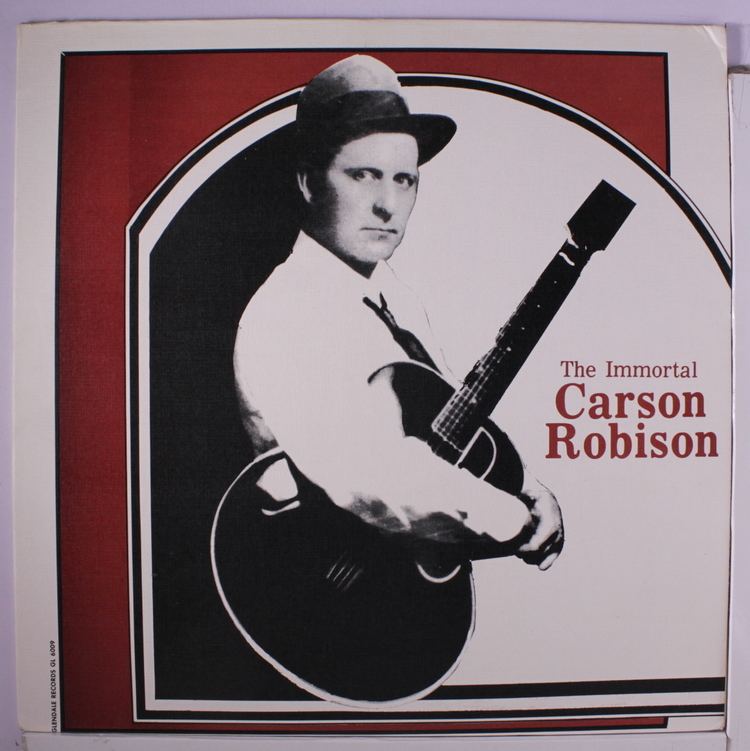Birth name Carson Jay Robison Name Carson Robison Also known as Charles Robison Role Singer-songwriter | Genres Country Years active 1924–1957 | |
 | ||
Born August 4, 1890Oswego, Kansas, USA ( 1890-08-04 ) Occupation(s) Musician, singer-songwriter, actor Albums Life Gets Tee-Jus Don't It Associated acts Similar Buell Kazee, Frank Luther, Vernon Dalhart | ||
Gene Austin & Carson Robison - Way Down Home - 1925 - Early Country Music
Carson Jay Robison ((1890-08-04)August 4, 1890 - (1957-03-24)March 24, 1957) was an American country music singer and songwriter. Although his impact is generally forgotten today, he played a major role in promoting country music in its early years through numerous recordings and radio appearances. He was also known as Charles Robison and sometimes composed under the pseudonym Carlos B. McAfee.
Contents
- Gene Austin Carson Robison Way Down Home 1925 Early Country Music
- Bud billings carson robison by the old oak tree 1930
- Early life
- Recording career
- Personal life
- Death and legacy
- Publications
- Albums
- Songs
- References

Bud billings carson robison by the old oak tree 1930
Early life

Carson Jay Robison was born in Oswego, Kansas. The son of a champion fiddler, he became a professional musician in the American Midwest at the age of 15, primarily as a whistler working with Wendell Hall, "The Red-Headed Music Maker", on the early 1920s music hall circuit. He worked as a singer and whistler at radio station WDAF (Kansas City, Missouri).
Recording career

In 1924, he moved to New York City and was signed to his first recording contract with the Victor Talking Machine Company. Also that year, Robison started a professional collaboration with Vernon Dalhart, one of the era's most notable singers. Through this relationship, Robison realized huge success, mainly as a songwriter but also as a musician, accompanying Dalhart on guitar, harmonica, whistling, and harmony vocals. In one of their first collaborations, Robison accompanied Dalhart on the landmark recording of "Wreck of the Old '97" b/w "The Prisoner's Song" (1924), widely regarded as country music's first million-seller. During this period, Robison also became a successful composer of "event" songs, which recounted current events or tragedies in a predictable fashion, usually concluding in a moral lesson. Some popular examples of his topical compositions include "The Wreck of the Shenandoah", "The Wreck of the Number Nine", and "The John T. Scopes Trial", about the famous Scopes Monkey Trial.
In 1928, after Dalhart made a personnel change without consulting Robison, their relationship ended. Although the breakup did not prove lucrative for either artist, Robison continued to record for decades to come. From 1928 to 1931 he teamed with Frank Luther, recording songs for various labels and appearing on WOR radio in New York City. In 1932, he started his own band, Carl Robison's Pioneers (later renamed The Buckaroos), and continued touring and recording through the 1930s and 1940s. It was during this period that Robison made some of the earliest tours of a country musician in the British Isles, appearing there in 1932, 1936, and 1938. According to Billboard, his 1942 recording of the standard "Turkey in the Straw" was that year's top selling country recording. In the late 1940s and early 1950s he appeared on the Grand Ole Opry. His most famous recording was 1948's "Life Gets Tee-Jus Don't It", a worldwide hit for MGM Records.
Although he played country music for most of his career, he is also remembered for writing the lyrics for "Barnacle Bill the Sailor" with music composed by Frank Luther. Also, in 1956, he recorded the novelty rock & roll song "Rockin' and Rollin' With Grandmaw."
Personal life
Robison was married twice. His first marriage was to Rebecca. They had a son C. "Donald". Don was raised by his Grandmother due to the untimely death of his mother, who died from TB in her early 20s. Eventually, both father and son settled in Pleasant Valley, NY. Don followed his father to this area, as he had moved close to New York City for easy access to better his career. During this time, he caught the eye of a young secretary working at the record label he was under contract to, Catherine "Catty" Robison. Carson and Catherine were married and had 3 children, Patricia, Robert and Kenneth.
His son C. Donald carried on his father's legacy, strictly as a non-professional music lover. He lived well into his 90s with his loving wife, Jean. This magical couple was married over 75 years.
Death and legacy
Robison died in 1957 in Poughkeepsie, New York.
